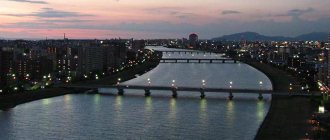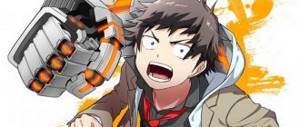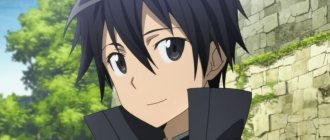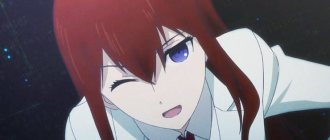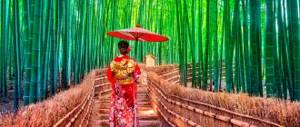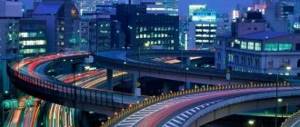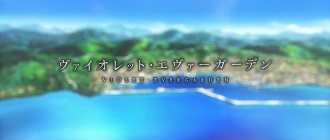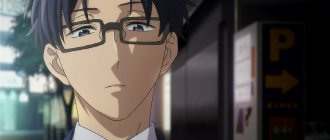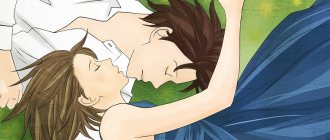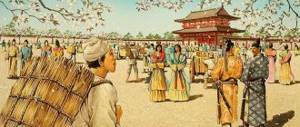Anime fans will find it hard to miss the wonderful Studio Ghibli Museum in Tokyo. Plunge into the world of Mononoke and Totoro, admire the cute characters and kawaii faces with big eyes! Find out how to get to the museum and how much tickets cost.
In 1985, Japanese director and screenwriter Hayao Miyazaki founded a new animation studio. Europeans call it “Ghibli”, but the Japanese themselves pronounce this word differently - “Jiburi”. It was here that full-length films and anime series were shot, which became popular all over the world.
In 2001, an unusual park museum was created at Studio Ghibli in Japan. It is interesting for children and adults who are not indifferent to animation.
What to see at the Ghibli Museum
First of all, on the characters of animated films that became hits in anime - “Princess Mononoke”, “Spirited Away” and “My Neighbor Totoro”. The exhibition hall on the lower floor is dedicated to the history of hand-drawn animation, and on the first floor a full-size model of the animation studio is made.
The Ghibli Museum houses sketches for the animated film “Hedgehog in the Fog” by Yuri Norshtein. The Japanese simply adore this domestic cartoon!
Tourists are shown the original office of Japanese animator Hayao Miyazaki. The museum has a real cinema where you can see the latest films from Studio Ghibli, there is a bookstore, a souvenir shop and a cafe. On the roof of the building there is a garden with a statue of the anime hero “Laputa Castle in the Sky”.
Tours are conducted in Japanese only. Photography inside the Ghibli Museum is strictly prohibited. Don't be upset! You won't be left without photos. Professional photographs are sold to tourists at very reasonable prices.
Studio Museum (Photo: henrymatt / flickr.com)
Application
Two years have passed since Studio Ghibli's latest anime, Memories of Marnie, premiered. Recently, producer and co-founder of Ghibli, Toshio Suzuki, made several statements. He emphasized that even when there is a short break in the work of the studio, this does not mean that the company is not working at all. Moreover, the fact that Ghibli is taking on projects with different themes (even if different from the usual ones) does not mean that the studio is retreating from its craft or losing its skills.
Good news for fans of Ghibli animation came in December. It turned out that the studio is involved in the production of the film “The Red Turtle” by European director Michael Dudok de Wit. But, if this film does not have time to be filmed this year, then Studio Ghibli still has something to please. The company will soon present one small but very significant project.
| "The Red Turtle" directed by Michael Dudok de Wit |
Many of Ghibli's successful anime films (such as Kiki's Delivery Service, Whisper of the Heart, and Howl's Moving Castle) are adaptations of original works, where the studio uses the original story as source material for an animated video. At the same time, experts leave a classical overtone in it. Artistic and design developments, together with the original history, will form the basis of the painting “Choju Jinbutsu Giga,” or “Scrolls of Stories of Mischievous Animals.” Created in the 12th and 13th centuries, they are considered the earliest examples of manga (analogous to ancient comics) in Japanese history. Considering that these stories are over seven centuries old, it was obvious why Choju Jinbutsu Giga had been left out of animation production until now. But the Ghibli artists set out to breathe life into this ancient, simultaneously detailed and abstract work of art.
Despite the fact that the studio had to work with such ancient models, the final video shows a distinctive meaning, as well as the impulse that the studio put into bringing the characters to life, harmoniously blending them into the environment. Ghibli did not make an exact copy of a historical work.
The mini-movie was produced as part of a project funded by energy company Marubeni Shin Denryoku. Environmental issues were taken as the basis. Including issues of environmental pollution, renewable energy, wind, water and solar energy production.
"Choju Jinbutsu Giga" was chosen as a symbol of the natural beauty of Japan's pre-industrial era. Studio Ghibli liked this eco-idea. According to Marubeni Shin Denryoku's plan, part of the revenue from customer payments is allocated to nature conservation projects. As part of the two companies' ongoing collaboration, Studio Ghibli producer Toshio Suzuki and Marubeni executive Satoshi Fukuda will meet to discuss a range of environmental issues that could yet be translated into video format. Some may be surprised by the commercial side of Studio Ghibli's work, but this won't be the first time the company has been involved in an ad production. But when they put their soul into it, and take a work of art as a basis, won’t it be worthy of viewing, even if it’s an advertisement?
Based on materials from online publications.
Opening hours and ticket prices
The museum is open from 10:00 to 18:00. Find information about the exhibitions and history of the studio on the official website of the Ghibli Museum.
A Ghibli Museum ticket costs 1,000 yen for adults, 700 yen for children 13 to 18 years old, 400 yen for children 7 to 12 years old, and 100 yen for children 4 to 6 years old.
Buying tickets is not so easy! 2-3 days before your visit, come to any Lawson store and make a purchase from the Loppi machine. Take someone with you who understands Japanese characters. During school holidays, we advise you to take care of your tickets 2-3 weeks in advance!
Film film "Arrietty from the Land of Lilliput"
Ghibli Museum
- Address:
1 Chome-1-83 Shimorenjaku, Mitaka, Tokyo 181-0013, Japan - Telephone:
+81 570-055-777 - Official website:
ghibli-museum.jp/en - Opening hours:
daily 10:00-18:00, closed Tuesday - Opening:
October 1, 2001 - Architect:
Hayao Miyazaki
One of the main symbols of Japan is the anime culture. It, in turn, is difficult to imagine without the cartoons of the legendary director Hayao Miyazaki. It was he who gave viewers many exciting animated films, to which the Studio Ghibli Anime Museum in Tokyo is dedicated.
History of the Ghibli Museum
Initially, in 1985, the world-famous Japanese director Hayao Miyajaki founded the animation studio Ghibli, where he later filmed his famous works. In 1998, the director decided to create a museum of the same name based on the anime Studio Ghibli in Tokyo, photos of which are presented below. Construction began in 2000, and on October 1, 2001, its official opening took place.
Architectural style of the Ghibli Museum
Despite the fact that this institution is called an art museum, it itself differs in many ways from usual museums. Hayao Miyazaki worked on its creation, trying to reproduce the setting and atmosphere of his cartoons. At the same time, he was inspired by European architecture, especially the buildings of the Italian commune of Calcata. Therefore, even the building of the Studio Ghibli anime museum in Tokyo is part of the exhibition.
There are not many exhibits here, but there are many details that immerse you even more in the animated world. These are various stairs, labyrinths, corridors, animal tracks on the paths and their small figures.
Displays and exhibitions of the Ghibli Museum
When creating this art gallery, Hayao Miyazaki focused primarily on children. This does not mean that the Ghibli Museum will not be of interest to adult visitors, especially fans of Japanese anime and manga. It is designed in the form of a labyrinth, in each section of which characters from the following cartoons by the great director await guests:
- “My neighbor is Totoro”;
- "Spirited Away";
- "Laputa Castle in the Sky"
- "Howl's Moving Castle" and many others.
Moreover, the features of these animated films can be read literally from the gates of the Ghibli Museum, which bear the name of the furry creature Totoro. The museum building itself is small in size and looks like a 19th century French house.
The ground floor of the Studio Ghibli anime museum in Tokyo is dedicated to an exhibition hall that clearly demonstrates the history of animation. Well-known characters are also presented here. Thanks to mechanical devices, they literally come to life in front of the audience.
On the ground floor of the museum there is a room called the mini-Louvre. It is a mock-up of a real animation studio, decorated with Hayao Miyazaki's sketches and reference materials. There is even a master’s office here, in which creative chaos reigns. Thanks to this hall, visitors have the opportunity to see with their own eyes how animation masterpieces are created.
The most popular places among guests of the Ghibli Museum are the plush bus and the huge robot, which can be seen in the cartoon “Laputa Castle in the Sky.” It should be remembered that photography is prohibited on the territory of the center.
In addition to permanent exhibitions, the Ghibli Museum in Japan hosts exhibitions highlighting the work of other animation studios. So, from 2001 to 2011, exhibitions on the following cartoons were held here:
- "Welcome to the Saturn Theater";
- "Louvre";
- "Goldilocks and the Three Bears";
- “Ponyo the fish on the cliff” and others.
At various times, here you could see materials related to the creation of films by Pixar, Aardman Animations, and Russian animator Yuri Norshtein.
Infrastructure of the Ghibli Museum
This gallery is aimed at visitors of different ages, for whose comfort they work here:
- souvenir shops;
- book Shop;
- cafe;
- game room;
- a cinema that shows short films specially created by Hayao Miyajako himself.
This Japanese museum is very popular among foreign guests and local residents, so getting tickets here is quite problematic. Tourists who do not know what time to start booking tickets to the Ghibli Museum should take care of this before departure. In this case, it is better to contact Studio Ghibli representatives directly. Otherwise, you will have to do this through a special machine, which is understandable only to those who are fluent in Japanese.
How to get to the Ghibli Museum?
In order to visit this interesting place, you need to travel 10 km west of ]Tokyo[/anchor]. Nearby there is a large tennis court, a hospital and a primary school. From the center of Japan's capital, you can take the metro to the Ghibli Museum. Just 1.5 km away are Inokashirakoen and Mitaka stations, which are connected to most of the main metro lines. Directly at Mitaka Station you can change to a yellow shuttle bus that will take you to your destination.
If you drive along Capital Highway No. 4 Shinjuku Line and Ino-dori Avenue/Tokyo Route No. 7, then the entire journey to the Ghibli Museum will take 36 minutes.
The magical world of Studio Ghibli
The films of Studio Ghibli directed by Hayao Miyazaki are true art, deep philosophy and magic that have captivated millions of people around the world. We'll go to the magical Studio Ghibli museum, where every anime fan wants to go. I will help you buy tickets that are very difficult to get, take you through the most interesting places in the museum, and also tell you interesting facts about Miyazaki and his cult films: “Spirited Away,” “My Neighbor Totoro,” “Princess Mononoke” and many others!
BOOK A TOUR
Chingiz guide in Tokyo Usually responds within 15 hours. I have lived in Japan for over 20 years. Journalist, professional translator, caring father of two children. In the 90s I came to study, after my doctoral studies I worked in Japanese and foreign companies. But what fascinated me most was journalism. The costs of being a television journalist are that the on-air reporting leaves too much “behind the scenes”... And I will share with you these “goodies”, the whole lively and fascinating picture of Japan.
EXCURSION DETAILS
Ghibli Museum, Mitaka, Tokyo (Japan)
Fans of Japanese animation will be interested in the Ghibli Museum from the famous animation studio Ghibli Studio Ghibli . The museum is dedicated to Japanese anime produced by this studio. It is located in the city of Mitaka , in the southwestern part of Inokashira Park, in the western part of Tokyo Prefecture, Japan.
The creator of this wonderful museum is the well-known Japanese animator and director Hayao Miyazaki , who is the author of many Japanese works such as Spirited Away, My Neighbor Totoro, Princess Mononoke, Howl's Moving Castle and other animated films that have become iconic and shaped the Japanese animation that exists today.
Ghibli Museum himself, drawing sketches, just as he did similar ones for his films. The design of the museum was also influenced by European architecture, such as that in Calcata, Italy. The museum building itself is also part of the exhibition. Construction of the museum began in March 2000 and its official opening took place on October 1, 2001.
Getting to the museum of the Ghibli anime studio “Ghibli Museum” in Mitaka is not so easy; the museum’s area in Inokashira Park is small and it is very difficult to accommodate all visitors, so tickets should be booked in advance. This can be done in Tokyo using special machines that can be found in Lawson stores, but it should be said that the machine communicates using hieroglyphs. Or find international representatives of Studio Ghibli and purchase tickets from them, but this is not always so easy. You can get to the museum from Tokyo Station, the trip will take about half an hour. You can also take a bus from the station in Mitaka to the museum. This bus is different from the others; it has various cartoon animals painted on it. You can also walk from Mitaka through Inokashira Park, which will take about 15-20 minutes.
The entrance to the museum is the Totoro Gate, which bears the coat of arms of the Ghibli Museum. In the window at the entrance you can see Totoro himself, who sells tickets. But this is not a real ticket kiosk and tickets must be purchased in advance. The actual entrance is quite crowded, especially with a lot of Japanese children who came with their parents. It should also be noted that, unfortunately, photography is prohibited on the territory of the museum, so the vivid impressions will be left only in your memory. The tickets themselves are made quite nicely, they contain part of the film with footage from the films of Studio Ghibli.
The museum building is small, entering here you feel as if you are in a labyrinth, passing through which you meet numerous characters from your favorite animated films. Here you can see how anime is born, watch exclusive cartoons that were created especially for the museum and you won’t see them anywhere else. The building consists of three floors. On the ground floor of the Ghibli Museum you can see how cartoon characters come to life: mechanical devices set figures of well-known characters in motion. On the second floor there is a model of an animation studio; the walls are hung with various sketches and drawings, and you can follow the entire process of creating an animated film. You can notice that the drawings of cartoon characters here are not only from the Ghibli studio but also from others, for example from the Soviet cartoon “Hedgehog in the Fog.” Also, sometimes you can find a real artist drawing sketches at one of the tables; curious visitors constantly crowd around him. Children will be interested in the room in which there is a huge plush bus - nekobas, inside of which there are makurokurosukes lying around. There are always a lot of children here and children are allowed into the room in small groups.
To climb to the roof of the building you need to walk along a narrow spiral staircase, which at first glance is designed for children. There is a green garden on the building, walking along the street in this garden you can come to the most interesting and photographed exhibit - a robot from the anime “Laputa Castle in the Sky”, as in the film he is just as sad, neighing, and because of the casing that has fallen off in places, wires are visible, mechanisms, hoses. Also nearby is the black box from the same animated film.
The Ghibli Museum also has a cafe that sells ice cream, juices, and hot dogs to snack on during the tour. There is also a bookstore and souvenir shops where you can buy exclusive souvenirs for yourself, your children and friends that can only be bought here, for example: figurines of your favorite characters, movie CDs, T-shirts, mugs, plush toys, notebooks, pens.
Description of the excursion
What awaits you
Touch the magic of animation After a quarter with original shops and Inokashira Park, we will go to the Studio Ghibli Museum. The museum building looks very compact from the outside, but its interior is carefully thought out, lovingly decorated and unexpectedly spacious. Those who are familiar with the world of Miyazaki will encounter interesting details and references to his anime at every step. The museum consists of a complex interweaving of floors, platforms, levels, each of which can be reached in different ways. On the underground floor you will visit the cinema hall with an entrance ticket made from real film. We will look at the exhibition dedicated to Japanese animation and talk about its specifics. Along the way, I will tell you interesting details about the films of Studio Ghibli, and on the roof you can take a photo with the kind robot warrior from the film “Laputa Castle in the Sky.”
Visit Miyazaki's workshop On the third floor we will visit the creative workshop of the legendary Miyazaki, where authentic relics are exhibited - sketches and sketches of the Master. Each cartoon requires great perseverance and a colossal amount of preparatory information. That is why the drawings of Miyazaki’s works are realistic to the smallest detail, and historical facts, landscapes, events and personalities are carefully restored. Here you will learn how the director worked on his creations and created a fabulous atmosphere inside each world.
And at the exit there is a souvenir shop where you can buy dolls of Studio Ghibli characters, postcards and badges as souvenirs!
Who is this excursion suitable for?
For a visitor of any age, a visit here will be a significant event and, to be honest, it may change your life! Adults will get acquainted with the stunning world of Hayao Miyazaki, and children will be happy to run along secret staircases, find hidden doors, climb Catbuses from the film “My Neighbor Totoro” and much more!
Organizational details
- Tickets to the museum sell out within hours for a month in advance. However, for residents of the Mitaka area (and I live here) there is a separate quota, under which there is a much greater chance of buying tickets, which we will take advantage of.
- Tickets must be purchased in advance , at least 2.5 - 3 weeks in advance . The ticket indicates the time of visit and the day; admission to the museum is between 10:00 and 12:00, 14:00 and 16:00. The museum is open until 18:00, closed on Tuesday. On weekends and during Japanese school holidays, tickets are often sold out months in advance on weekdays.
- I will arrange tickets for you to the museum and meet you in the hotel lobby (either at one of the stations on the JR Yamanote loop line or the JR Chuo line). We then travel to the museum by public transport (or taxi if you choose to call one), where I will give you a tour and leave you at the museum after explaining how to get to Shinjuku or Tokyo Station on your own.
- Entrance fees : adults - 1,000 yen, teenagers (13-18 years old) - 700 yen, children (7-12 years old) - 400 yen, children (4-6 years old) - 100 yen. In addition, you pay for my ticket (unfortunately, without my presence the museum will not let you in with tickets according to quotas for area residents), as well as the cost of your and my travel from the meeting point to the museum.
- If your hotel is located far from the Yamanote ring road, but you definitely need to be picked up and/or escorted back or to another point after visiting the museum, please let me know in advance so that I can revise the cost of the excursion.
Book a tour on any of the available days on the calendar
- This is an individual excursion
in Russian, the guide will conduct it for you and your company. - On the website you pay 20% of the cost
, and the rest goes to the guide on the spot. You can ask the guide any questions before paying.
BOOK A TOUR
0
Author of the publication
offline 3 years
